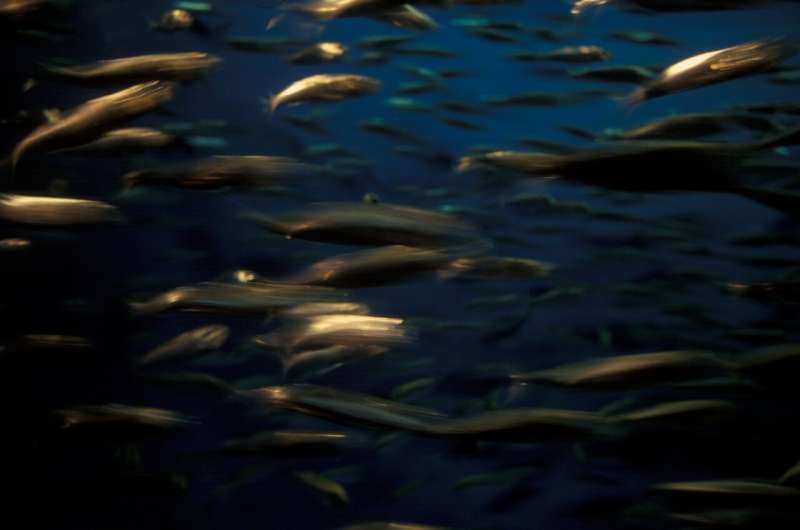May 13, 2025 report
This article has been reviewed according to Science X's and . have highlighted the following attributes while ensuring the content's credibility:
fact-checked
peer-reviewed publication
trusted source
proofread
Collective memory loss in herring results in 800 km shift in spawning grounds

Researchers led by the Institute of Marine Research in Norway report an 800 km poleward shift in the spawning grounds of Norwegian spring-spawning herring (NSS herring) following a loss of collective migration memory among older fish due to age-selective fishing. Findings indicate potential disruptions to coastal food webs and present challenges for fisheries management.
Entrainment, the process by which migratory routes are transferred from experienced spawners to recruits through social learning, is integral to the migratory culture of schooling fish populations. Previous research has indicated that age-selective fishing targeting older fish can disrupt cultural transmission, fragmenting established migration routes.
Historically, NSS herring migrated as far as 1,300 km southward from wintering areas in northern Norwegian waters to spawn along the west coast at Møre, a route proposed to balance the energetic costs of long-distance swimming with the benefits of improved larval survival in southern waters.
In the study, "Herring spawned poleward following fishery‑induced collective memory loss," in Nature, researchers conducted an integrative observational analysis combining fisheries records, scientific acoustic-trawl surveys, and tagging experiments to assess whether disrupted social learning altered spawning geography.
Data spanning 1995 to 2024 were obtained from Norwegian, Icelandic, and Faroese fisheries, representing approximately 80% of the total herring catch as reported to the International Council for the Exploration of the Seas.
Scientific acoustic-trawl surveys conducted annually from 2018 to 2024 provided quantitative data on migration routes, feeding grounds, and spawning areas. Surveys were performed during peak migration periods to capture variations in spatial distribution and school composition.
Between 2016 and 2023, 202,155 herring were tagged in northern Norwegian fjords using Passive Integrated Transponder (PIT) tags. Tag recapture data, collected at processing facilities equipped with RFID antennas, were cross-referenced with acoustic survey data to track migration routes and spawning locations.

Analysis of fisheries records, acoustic-trawl surveys, and tagging data indicated a substantial northward migration, with the center of spawning activity shifting approximately 800 km from Møre to Lofoten.
Acoustic-trawl survey data and tagging records revealed that the 2016 cohort established new spawning routes in northern waters, diverging from historical migration patterns associated with older age classes. The 2016 cohort bypassed the traditional southern route to Møre, initiating the northern route to Lofoten, a pattern that became prominent from 2021 onward.
Spawning season surveys confirmed a 68% decline in the biomass of older spawners, decreasing from approximately 4.0 million tons in 2019 to 1.3 million metric tons in 2023. During these surveys, the 2016 cohort maintained sufficient biomass to sustain spawning activity, comprising over 50% of the spawning population by 2021.
Acoustic-trawl data indicated a marked reduction in spatial overlap between recruits and older fish during spawning periods, limiting opportunities for cultural transmission of migratory routes.
Recapture data from tagged individuals confirmed that subsequent cohorts progressively adopted the newly established northern migration route, reinforcing the observed shift in spawning geography.
Findings suggest that the poleward shift in spawning grounds of NSS herring may result in long-term alterations to migratory patterns driven by the loss of social learning, a consequence of reduced interactions between older spawners and recruits.
The 800 km shift, which became evident as the 2016 cohort reached numerical dominance in 2021, represents a significant departure from historical migratory routes with a wide range of implications for prey availability within the food web and nutrient fluxes in southern waters.
Now that a new migratory pattern has emerged, reinforced by collective migration memory, restoring historical patterns may be impossible.
More information: Aril Slotte et al, Herring spawned poleward following fishery-induced collective memory loss, Nature (2025).
Journal information: Nature
© 2025 Science X Network


















